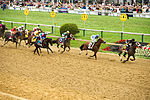Pimlico Race Course
1870 establishments in MarylandPimlico Race CourseSports venues completed in 1870Stronach Group

Pimlico Race Course is a thoroughbred horse racetrack in Baltimore, Maryland, most famous for hosting the Preakness Stakes. Its name is derived from the 1660s when English settlers named the area where the facility currently stands in honor of Olde Ben Pimlico's Tavern in London. The racetrack is nicknamed "Old Hilltop" after a small rise in the infield that became a favorite gathering place for thoroughbred trainers and race enthusiasts. It is currently owned by the Stronach Group.
Excerpt from the Wikipedia article Pimlico Race Course (License: CC BY-SA 3.0, Authors, Images).Pimlico Race Course
Merville Avenue, Baltimore
Geographical coordinates (GPS) Address Nearby Places Show on map
Geographical coordinates (GPS)
| Latitude | Longitude |
|---|---|
| N 39.353611111111 ° | E -76.673055555556 ° |
Address
Merville Avenue
21215 Baltimore
Maryland, United States
Open on Google Maps






